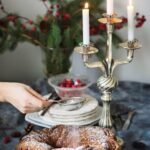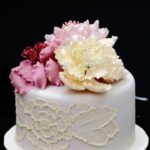Whether you’re a professional pastry chef or an amateur baker, knowing how to make chocolate for cake decorating is an essential skill in the world of confectionery. The use of chocolate in cake decorating dates back centuries, and its versatility and rich flavor have made it a staple in the pastry kitchen.
From creating intricate designs to adding a decadent finish to your cakes, mastering the art of working with chocolate can elevate your baking game to the next level.
In this article, we will explore the history of chocolate and its significance in cake decorating. We’ll uncover the different types of chocolate available for use in your confections, as well as provide guidance on selecting the right chocolate for your specific needs. Whether you’re looking to create delicate piped designs or smooth and shiny ganache finishes, we’ll cover various techniques for melting and using chocolate to enhance the visual appeal of your cakes.
Understanding the properties of chocolate and learning how to harness its potential can open up a world of creative possibilities in cake decorating. With step-by-step guides and troubleshooting tips, you’ll be equipped with the knowledge and skills needed to showcase beautiful, chocolate-decorated cakes that will impress friends, family, or customers. Join us as we delve into the fascinating world of using chocolate for cake decorating – it’s time to unleash your inner chocolatier.
Types of Chocolate
When it comes to cake decorating, choosing the right type of chocolate is essential for achieving the desired results. There are several varieties of chocolate available, each with its own unique characteristics and uses in cake decorating. Whether you’re looking to create a smooth and shiny ganache or intricate chocolate decorations, understanding the different types of chocolate is crucial.
Here are some of the most common types of chocolate used in cake decorating:
- Milk Chocolate: This type of chocolate has a creamy and sweet flavor, making it a popular choice for creating smooth and flavorful ganache.
- Dark Chocolate: With its rich and intense flavor, dark chocolate is perfect for creating bold and decadent decorations on cakes.
- White Chocolate: While technically not true chocolate as it doesn’t contain cocoa solids, white chocolate adds a creamy and sweet element to cake decorating projects.
- Compound Chocolate: This type of chocolate is made with vegetable fat instead of cocoa butter, making it more stable for creating decorations that need to hold their shape at room temperature.
When selecting the right type of chocolate for your cake decorating project, consider the flavor profile you want to achieve as well as the specific techniques you’ll be using. Understanding the characteristics of each type of chocolate will help you make an informed decision when choosing the best chocolate for your next cake decorating masterpiece.
Selecting the Right Chocolate
Understanding Different Types of Chocolate
When it comes to selecting chocolate for cake decorating, it’s essential to understand the different types available. Dark chocolate, milk chocolate, and white chocolate each have unique flavor profiles and cocoa content. Dark chocolate has a higher cocoa content and a more intense flavor, while milk chocolate is creamier and sweeter. White chocolate is made from cocoa butter, sugar, and milk solids, giving it a rich and buttery taste.
Considerations When Choosing Chocolate
When choosing the best chocolate for your cake decorating project, consider the cocoa content, sweetness level, and intended use. For example, if you’re creating intricate decorations or piped designs, opt for a higher quality dark or milk chocolate with excellent tempering properties. If you’re making ganache or drizzling chocolate over cakes, a smoother melting milk or white chocolate may be more suitable.
Sourcing High-Quality Chocolate
To achieve top-notch results in cake decorating with chocolate, sourcing high-quality products is essential. Look for reputable brands known for their excellent quality and taste. Consider purchasing couverture chocolate, which contains a higher percentage of cocoa butter than standard baking chocolates. This will ensure better fluidity when melted and a smooth finish when used for decoration.
By carefully selecting the right type of quality chocolate for your cake decorating project, you can elevate the appearance and taste of your creations while impressing friends and family with professional-looking confections.
Chocolate Melting Techniques
Using a Double Boiler
One of the most common and effective ways to melt chocolate for cake decorating is by using a double boiler. This method involves placing a heatproof bowl over a pot of simmering water, allowing the steam to gently melt the chocolate. It’s important to avoid direct heat when melting chocolate, as it can cause the chocolate to burn and become lumpy. The double boiler method ensures that the chocolate melts slowly and evenly, resulting in a smooth consistency.
Microwave Method
For those who prefer a quicker method, melting chocolate in the microwave can also be an option. To do this, simply place the chopped chocolate in a microwave-safe bowl and heat it in short bursts at a low power setting. It’s crucial to keep an eye on the chocolate and stir it frequently to prevent overheating. The microwave method is convenient and efficient, but it requires careful attention to avoid scorching or burning the chocolate.
Bain-Marie Technique
Another technique for melting chocolate is the bain-marie, which involves placing the chopped chocolate directly into a bowl set over a pan of hot water. The bowl should not touch the water directly but should be heated by the steam from the hot water beneath it. This gentle heating method allows for precise control over the temperature of the chocolate, making it ideal for delicate cake decorating projects where a smooth and glossy finish is desired.
By mastering these different melting techniques, cake decorators can ensure that their chocolate is perfectly melted and ready to use for creating stunning decorations on their cakes. Whether using a double boiler, microwave, or bain-marie, proper melting techniques are essential for achieving beautiful results when working with chocolate in cake decorating.
Making Chocolate Ganache
Creating a rich and luscious chocolate ganache can add a decadent touch to your cake decorating projects. Whether you’re covering a cake or using it as a filling, mastering the art of making ganache is essential for any baker. Here’s a step-by-step guide to help you create a smooth and shiny ganache for your cake decorating needs:
Ingredients
- Semisweet or bittersweet chocolate, finely chopped
- Heavy cream
- Optional flavorings (vanilla extract, liqueur, etc.)
Steps
- Heat the heavy cream in a saucepan over medium heat until it begins to simmer.
- Place the finely chopped chocolate in a heatproof bowl.
- Pour the hot cream over the chocolate and let it sit for a few minutes to allow the heat to melt the chocolate.
- Gently whisk the mixture starting from the center until it becomes smooth and glossy.
- Add any optional flavorings at this point if desired.
- Allow the ganache to cool at room temperature until it reaches your desired consistency before using it for decorating.
By following these steps, you can easily create a luxurious ganache that will elevate your cake decorating projects. Whether you’re covering an entire cake with ganache or using it as a filling for layered cakes, this versatile chocolate mixture is sure to impress both you and your guests. Enjoy experimenting with different flavors and consistencies to achieve the perfect ganache for your next cake masterpiece.
Using Chocolate for Piping and Drizzling
When it comes to cake decorating, using melted chocolate for piping and drizzling can add a beautiful and delicious touch to your creations. Whether you are looking to add intricate designs or a simple yet elegant touch to your cakes, mastering the technique of using melted chocolate is essential.
One technique for using melted chocolate for piping is to fill a small piping bag with the melted chocolate, gently squeeze the bag to create the desired design on parchment paper, and allow it to harden before carefully transferring it onto your cake. Alternatively, you can use a zip-top bag and cut a small hole in one of the corners to achieve the same effect.
When drizzling chocolate over a cake, make sure the chocolate is at the right temperature so that it flows smoothly and evenly over the surface of your cake.
Another method for adding melted chocolate decorations to cakes involves using molds. By pouring melted chocolate into molds and allowing them to set before popping them out, you can create beautifully shaped decorations such as hearts, flowers, or even intricate lace designs. These can then be placed strategically around your cake for an added touch of elegance.
In addition to being used for decorative purposes on cakes, melted chocolate is also commonly drizzled over finished desserts such as cheesecakes, tarts, and pies. This adds visual appeal while also providing an extra layer of flavor that enhances the overall taste experience. Mastering the art of using melted chocolate for piping and drizzling will undoubtedly take your cake decorating skills to new heights and impress anyone who gets a chance to enjoy one of your beautifully adorned creations.
| Technique | Description |
|---|---|
| Piping with Melted Chocolate | Using a small piping bag or zip-top bag with a small hole in one corner |
| Molded Decorations | Creating shapes with molds |
| Drizzling Technique | Ensuring smooth flow over desserts |
Creating Chocolate Decorations
When it comes to cake decorating, chocolate decorations add an elegant and delicious touch to any dessert. Creating chocolate curls, shavings, and other decorations may seem daunting at first, but with the right techniques and a little practice, you can easily elevate the look of your cakes.
To make chocolate curls, start by melting high-quality chocolate using a double boiler or in the microwave at 50% power in short intervals. Once melted, spread the chocolate onto a baking sheet in a thin layer. Let it cool until it becomes slightly firm, but still pliable.
Use a sharp knife or a metal spatula to carefully scrape the chocolate into small curls. These curls can then be gently arranged on top of your cake for a professional and beautiful finish.
Another popular decoration technique is making chocolate shavings. To achieve this delicate decoration, use a vegetable peeler to carefully shave off thin strips of cooled, solidified melted chocolate. The resulting shavings can be sprinkled over your frosted cake for an elegant and sophisticated look that will impress your guests.
In addition to curls and shavings, you can also create other shapes and designs using melted chocolate. By using piping bags or squeeze bottles with small tips, you can drizzle or draw intricate patterns on parchment paper before allowing them to set.
Once hardened, these decorative shapes can be carefully peeled off the paper and placed on your cake to add dimension and visual interest. With these simple techniques, you can take your cake decorating skills to the next level and create stunning desserts that are as beautiful as they are delicious.
| Chocolate Decoration | Technique |
|---|---|
| Chocolate Curls | Melted chocolate spread thin then scraped |
| Chocolate Shavings | Use vegetable peeler on cooled solidified melted chocolate |
| Other Designs | Melted chocolate piped onto parchment paper then peeled off once set |
Troubleshooting Common Chocolate Decorating Issues
When working with chocolate for cake decorating, it is important to understand that you may encounter some common issues along the way. These problems can include seizing, blooming, and overheating of the chocolate. However, with the right knowledge and troubleshooting techniques, these issues can be easily resolved.
One common problem when working with chocolate is seizing, which occurs when the chocolate comes into contact with even a small amount of water. This causes the chocolate to become lumpy and unusable. If this happens, you can try adding vegetable oil or cocoa butter to the chocolate and stirring continuously until it becomes smooth again.
Another issue that may arise when decorating cakes with chocolate is blooming. Blooming happens when the cocoa butter in the chocolate rises to the surface, creating a whitish film on the finished product. To prevent blooming, ensure that your chocolate is properly tempered before use and store your finished decorated cake in a cool, dry place.
Finally, overheating of chocolate can also cause problems when cake decorating. If your melted chocolate becomes too hot, it can become thick and difficult to work with. To fix this issue, you can try adding more unmelted chocolate to bring down the temperature or stirring in a small amount of shortening to help thin it out.
By understanding these common issues and knowing how to troubleshoot them effectively, you can ensure that your experience with using chocolate for cake decorating is smooth and successful. Don’t let these common problems discourage you from experimenting with different techniques and creating beautiful chocolate-decorated cakes.
Conclusion
In conclusion, learning how to make chocolate for cake decorating can open up a world of creative possibilities in the kitchen. From understanding the different types of chocolate available to perfecting the art of melting, piping, and drizzling chocolate, there are endless techniques to explore. With the step-by-step guide on making chocolate ganache and creating stunning decorations, anyone can elevate their cake decorating skills with the use of chocolate.
By showcasing your beautifully decorated cakes, you can inspire others to try these techniques and unleash their own creativity. Whether it’s for a special occasion or just for fun, working with chocolate for cake decorating allows for personalization and a truly unique touch to any dessert.
Encouraging readers to explore and experiment with the tips and tricks learned in this blog post is not only a way to share the joy of cake decorating but also a way to spread the love of delicious chocolate creations.
Ultimately, working with chocolate for cake decorating is an art form that requires practice and patience. As with any skill, there may be challenges along the way, but by troubleshooting common issues and persevering through any setbacks, anyone can master the craft of using chocolate as a decorative element in baking. So go ahead, grab some chocolate, get creative, and let your imagination run wild as you embark on your own chocolate-decorating journey.
Frequently Asked Questions
What Chocolate Is Best for Cake Decorating?
The best chocolate for cake decorating is typically high-quality dark chocolate with at least 70% cocoa content. This type of chocolate has a rich flavor and melts smoothly, making it ideal for creating intricate decorations on cakes.
What Kind of Chocolate Do You Use for Chocolate Decorations?
When making chocolate decorations, it’s important to use couverture chocolate, which contains a higher percentage of cocoa butter. This type of chocolate has excellent fluidity when melted and sets up beautifully to create delicate decorations like curls, shavings, and molded shapes.
How to Make Chocolate for Decoration?
To make chocolate for decoration, start by melting the couverture chocolate slowly and gently using a double boiler or microwave. Once melted, pour the chocolate onto a parchment paper-lined baking tray and spread it into an even layer with an offset spatula.
Allow the chocolate to partially set before cutting or shaping it into decorations such as shards, curls, or discs. Be sure to handle the cooled decorations carefully as they can be quite fragile.

Welcome to my blog about home and family. This blog is a place where I will share my thoughts, ideas, and experiences related to these important topics. I am a stay-at-home mom with two young children. I hope you enjoy reading it! and may find some helpful tips and ideas that will make your home and family life even better!





